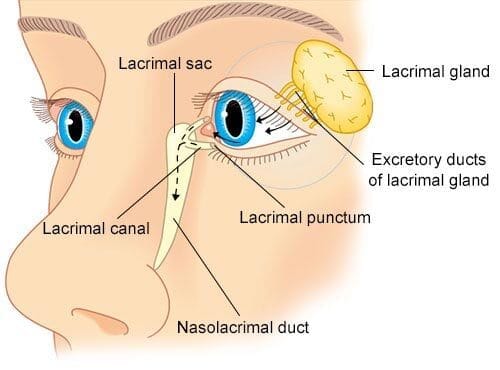 Tear gland inflammation, also known as dacryoadenitis, is an inflammation of the lacrimal gland. The lacrimal gland is positioned above the outer corner of each eye and is responsible for keeping the eyes wet and lubricated through tears. Tears are important for keeping the eyes healthy and functioning properly.
Tear gland inflammation, also known as dacryoadenitis, is an inflammation of the lacrimal gland. The lacrimal gland is positioned above the outer corner of each eye and is responsible for keeping the eyes wet and lubricated through tears. Tears are important for keeping the eyes healthy and functioning properly.
If you have a swollen tear duct, it may be painful to move your affected eye. Your tear gland may also generate excess tears, making your eyes moist. This condition normally doesn’t impair your vision, but if the swelling is significant enough to cause pressure on your eye, it can affect your ability to see. The prognosis is good, however, if you get effective dacryoadenitis treatment in time.
The optometrists at Eye Physicians in NYC are known for their experience and 24/7 on-call support. They provide the best tear gland inflammation treatment as well as treatment for other eye conditions such as:
The lacrimal apparatus is the anatomical mechanism that produces, distributes and drains tears. The lacrimal apparatus consists of multiple components, including:
Your Manhattan optometrist relies on advanced diagnostic tools and keeps up with the newest breakthroughs in eye care, ensuring that you receive the greatest degree of treatment. If you’re searching for the best optometrist near me in New York City, then your search is over.
Inflammation of the lacrimal gland can cause a variety of signs and symptoms unique to everyone. Common symptoms include:
These symptoms can vary in severity and may be accompanied by generalized signs of infection if the inflammation is caused by an infectious agent. If dacryoadenitis isn’t treated promptly or the underlying cause is not addressed correctly, complications can develop and may include:
Analyzing symptoms properly is vital for dacryoadenitis treatment. Treatment that’s tailored to specific symptoms increases its efficacy.
Dacryoadenitis can be caused by a variety of reasons, which are broadly classified into two main factors:
Some of these causes are acute, while others are chronic. Obstruction can be both acute and chronic, as persistent obstructions in the tear ducts can cause chronic symptoms. Many risk factors can lead to the onset of tear gland inflammation as well, and may include:
Read more: Retinal Laser Photocoagulation
Dacryoadenitis treatment is determined by the underlying causes and symptoms as well as a complete eye examination. This includes measuring redness, edema and tear production, as well as performing extra procedures like imaging or duct irrigation to pinpoint the source and duration of the problem. A general treatment approach to relieve pain may include:
Monitoring the disease and changing medication as needed are the foundations of successful tear gland inflammation treatment. Your NYC optometrist may recommend that you apply a warm compress to the affected eye, as well as how frequently, and for how long, you should use one. While complete prevention of dacryoadenitis is not assured, practicing effective eye hygiene is vital and includes:
In New York City, contact Eye Physicians for prompt, reliable and accurate care for your eyes. Avoid further complications and make an appointment at the first signs of tear gland inflammation symptoms.

My name is Dr. William Hogue, and I am an optometrist dedicated to providing top-quality professional eye care. I'm trained in treating various ocular conditions, including dry eye syndrome, glaucoma, and retinal issues.
I earned my chemistry degree summa cum laude from the University of Tennessee. Subsequently, I obtained my Doctorate of Optometry (OD) and Master of Science (MS) from the New England College of Optometry. Following graduation, I completed an ocular disease residency at the State University of New York’s College of Optometry. Beyond my clinical work, I have also been a supporter of Volunteer Optometric Services to Humanity (SVOSH).
More about Dr. HogueEye Physicians
110 Lafayette St, Suite 503
New York, NY 10013
(212) 292-4814
Entrust the care of your precious eyesight to highly skilled and experienced eye care professionals. For top-notch ophthalmologists and optometrists in Downtown Manhattan, choose Eye Physicians. Eye Physicians ensures prompt care, precise diagnosis, and personalized treatment plans.
Schedule an Appointment